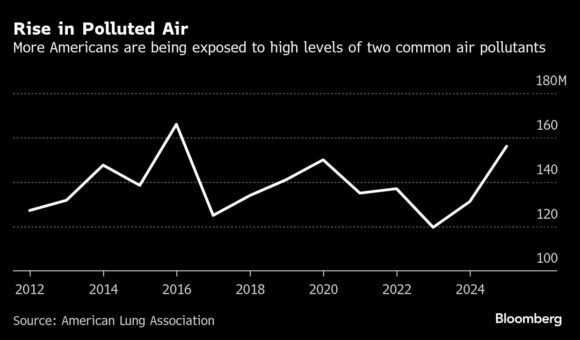Around 156 million Americans, nearly half of the US population, now live in areas with unhealthy levels of air pollution, part of a trend toward declining air quality as climate change-related extreme weather events like wildfires occur more frequently.
That’s according to the 2025 State of the Air report from the American Lung Association, which each year tracks air quality around the nation. The report, released Wednesday, focuses on two common and dangerous pollutants: ozone and fine particles. The number of Americans exposed to high levels of these has risen by about 25 million since last year’s report.

“Depending on where you live, you knew from looking out your window,” said Katherine Pruitt, the group’s national senior director for policy. “But, even expecting it, it was a surprise to us how much worse particularly ozone levels were in much of the country.”
The 2025 report is based on data from 2021 to 2023, years in which smoke from Canadian wildfires swept south to places like New York City and extreme temperatures scorched the southwestern US.
These kinds of extreme weather events can contribute to particle pollution, in which microscopic particles — formed when materials burn or from chemical reactions involving pollutants in the atmosphere — can enter the lungs and bloodstream and cause damage.
Ozone is a layer in the Earth’s atmosphere but can also form as a pollutant closer to the ground, where it’s often called smog. People can breathe in the corrosive gas, leading to inflammation in the lungs and other harmful reactions in the body. Both extreme heat and wildfires can promote the formation of ozone.
Nearly 43 million Americans live in areas with high levels of short-term and long-term particle pollution as well as ozone pollution, according to the report. Many more experience at least one of these hazards.
The geographic distribution of the problem has changed. Previously, high readings of ozone and particle pollution were concentrated in Western states, but in 2023, levels in the West eased. Meanwhile, the Midwest and Northeast saw greater daily spikes in particle pollution, and parts of the country including central states like Minnesota and Texas experienced unhealthy levels of ozone, the report authors found.
Still, the cities with the highest levels of ozone and particle pollution, respectively, are both in California: Los Angeles-Long Beach and Bakersfield-Delano.
Unhealthy air poses particular risks to vulnerable groups like children, seniors, people with asthma or other lung conditions and pregnant people and their unborn babies, Pruitt said. People of color also tend to live in areas with high levels of pollution, increasing their likelihood of exposure.
“Those are the people that are going to suffer the most and suffer first,” she said.
Research has found that continued exposure to particle pollution is associated with an elevated risk of premature death. Other health effects of air pollution include increased danger of preterm birth, heart attack, stroke, asthma and lung cancer.
While extreme weather is one factor that degrades US air quality, vehicles, power plants and factories also contribute substantially to such pollution. However, that’s been reduced over the years by regulation like the 1970 Clean Air Act, which resulted in the Environmental Protection Agency setting standards for air quality. Emissions of six major air pollutants have plummeted by nearly 80% since, even as the population grew and US energy consumption increased, according to the EPA.
“Breathers everywhere have been reaping the benefits of that cleanup for decades,” Pruitt said. “But as the population has grown, as the climate has been changing and we’ve had more extreme heat events and more droughts, leading to wildfires, we’ve started to see that trend reverse.”
Of the more than 3,000 counties in the US, just under 900 supplied sufficient air quality monitoring data on at least one pollutant to be included in State of the Air. The majority of counties don’t have any monitors. These tend to be more rural, with smaller populations.
The new findingscome as the Trump administration has proposed dramatic cuts to the EPA’s spending and targeted a rollback of air quality standards. The report highlights the role the federal government plays in air monitoring. Air quality forecasts, for instance, are made available by the EPA-supported site Airnow.gov, and the report authors relied on EPA databases for their analysis.
“EPA staff are the reason the nation has access to air quality data in the first place,” the report authors wrote.
Photo: A pedestrian wears a mask as smoke from Canadian wildfires blankets New York in 2023. Photographer: Alex Kent/Bloomberg
Copyright 2025 Bloomberg.
Topics
Catastrophe
Natural Disasters
Wildfire
Interested in Catastrophe?
Get automatic alerts for this topic.
#Americans #Breathe #Unhealthy #Air #Due #Wildfires #Extreme #Heat